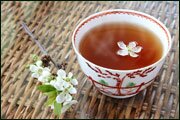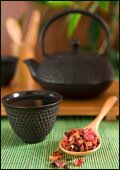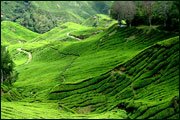The History of Tea

You will find that many people the world over drink tea without even thinking about the history of tea and how this history has shaped our lives. The many forms and tastes of tea can attest to the popularity this beverage has on our lives. Yet for all of our drinking this soothing cup of tea we seldom think about how tea has made its way into our lives. As you look at the histories of various countries you may find some legend, or story about tea and its origins in that country.
While all of these stories may be fantastic they do bear some grains of truth which are close to the history of tea as we know it. In many ways you can say that tea officially began life in China in 2737 B.C. During this time the emperor of China was Shen Nung, a man who was in many ways more advanced in his thinking than most of his contemporaries.
The history of tea really came into being during Shen Nung's time. One of Shen Nung's edicts during his rule was that all water which was to be drunk had to be boiled. In order to ensure that his kingdom was thriving well and the safety of his people was intact the emperor was in the habit of visiting various regions of China. It was during one of those visits that a favorable accident occurred and the history of tea began. After traveling for some time the emperor stopped for a rest and to have some water to refresh himself. While the emperor was resting his servants began to heat some water. It was during this time that some dried leaves from a nearby bush fell into the water. The boiling water mixed with the dried leaves and changed the water into a new beverage. The emperor decided to see what had happened to his water and liked the resulting taste.
This was the moment that tea was born. After that the drinking of tea spread into every sphere of Chinese life and culture. This is how the history of tea began in China. After some years had passed Zen Buddhist missionaries brought tea to Japan and soon after this it received imperial sponsorship. This assured tea's place in Japan's culture. In fact tea held a strong place in the Japanese culture that giving tea was viewed as giving an ultimate gift. The history of tea also cites that Warlords were known to stop their battles so that they could enjoy the pleasure of drinking a perfect brewed and served cup of tea.

Today you can still see the place tea has in the lives of Japanese people. The Japanese tea ceremony is one of the countries oldest traditions of brewing and serving a perfect cup of tea. The history of tea is not isolated to the eastern countries only. During the many interactions that Europeans had with the people they met during their trading ventures they learnt about the practice of drinking tea as a relaxing beverage. In 1589 European countries learned of tea. But they did not know much about it or why so many people in the Orient drink this beverage.
This uncertainty about tea continued until the Dutch came into contact with tea in person. When this occurred they discovered the smooth taste and the soothing feeling that comes with drinking tea. This discovery led them to importing tea back to their home country. To help promote the idea of drinking this new beverage these merchants of tea would spin some interesting tales about the history of tea in the countries where they had brought the tea from. From here on various European countries tasted tea and fell under its spell. These countries include Russia, France, Portugal, and later on England.
As life in these countries continued tea began to find favor with many people from across different social stratas. Tea was no longer confined to the wealthy to be drunk in fashionable places or in rigid social rules. Tea could be found as the firm favorite with many people at almost any hour of the day. By looking at the history of tea you will see how tea evolves into a meal in a class of its own.

In England, tea drinking evolved into a social pastime, and also as a way of bridging the time gap between lunch and late dinner. This led to the afternoon teas and high tea meals that many of us have heard of. In addition to these teas, the history of tea mentions that while the upper class enjoyed wafer thin sandwiches, ices, potted meats, shrimp and fish pates, toasted bread with some accompanying jams and dainty cakes with their afternoon tea, the working classes favored a more robust type of tea time. Their late evening tea would be comprised of mashed potatoes, roast beef, peas, and of course a well brewed pot of tea.
This love of tea made its way to America and as the history of tea and history itself shows us, there are many reasons why the Boston Tea Party is a starting point for the battle for independence. The main reason is that England tried to use the love of tea drinking among the women of the colonies as a way to force the colonists to pay taxes which were levied to them. The colonists retaliated by importing their supply of tea from other countries than England. This began the war between the colonies and England.
Of course not all of history of tea is steeped in violence. This refreshing beverage has many followers all over the world. Today you can see shops with many different varieties of tea. There are also many tea making and serving products which you can use both as souvenirs and also as a fancy way to make a good cup of tea. No matter what tea you drink or how you view it, the history of tea is one that is intermingled with our history and the culture of many different countries.
Disclaimer: The information contained on this site is not intended to replace the diagnosis, treatment, consultation and services of a qualified Medical Practitioner. All information presented is in summary form and intended only for informational purposes. Always seek immediate medical attention for any illness you may have and never disregard the advice from qualified Medical Practitioners as something you have read on this site (or related sites) could be misinterpreted.

